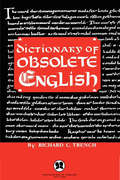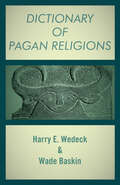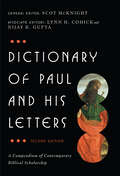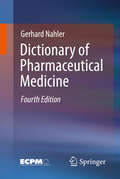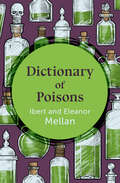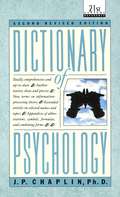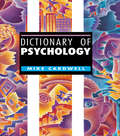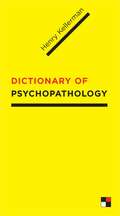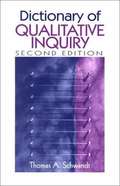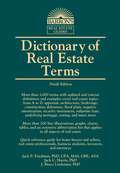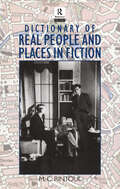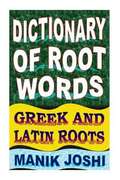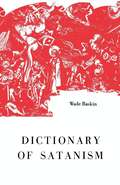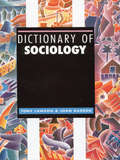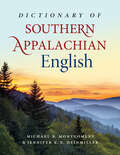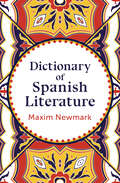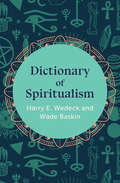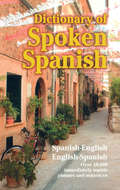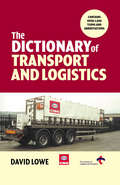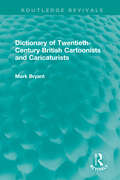- Table View
- List View
Dictionary of Newfoundland English
by W. J. Kirwin G. M. Story J.D.A. WiddowsonThe Dictionary of Newfoundland English, first published in 1982 to regional, national and international acclaim, is a historical dictionary that gives the pronunciations and definitions for words that the editors have called "Newfoundland English". The varieties of English spoken in Newfoundland date back four centuries, mainly to the early seventeenth century migratory English fishermen of Cornwall, Devon, Dorset and Somerset, and to the seventeenth to the nineteenth century immigrants chiefly from south-eastern Ireland. Culled from a vast reading of books, newspapers and magazines, this book is the most sustained reading ever undertaken of the written words of this province. The dictionary gives not only the meaning of words, but also presents each word with its variant spellings. Moreover, each definition is succeeded by an all-important quotation of usage which illustrates the typical context in which word is used. This well-researched, impressive work of scholarship illustrates how words and phrases have evolved and are used in everyday speech and writing in a specific geographical area. The Dictionary of Newfoundland English is one of the most important, comprehensive and thorough works dealing with Newfoundland. Its publication, a great addition to Newfoundlandia, Canadiana and lexicography, provides more than a regional lexicon. In fact, this entertaining and delightful book presents a panoramic view of the social, cultural and natural history, as well as the geography and economics, of the quintessential lifestyle of one of Canada's oldest European-settled areas. This second edition contains a Supplement offering approximately 1500 new or expanded entries, an increase of more than 30 per cent over the first edition. Besides new words, the Supplement includes modified and additional senses of old words and fresh derivations and usages.
Dictionary of Obsolete English
by Richard C. TrenchThis new edition of the well-known definitive glossary provides the key to those terms in the English language that have either changed their meaning or been altogether discarded . . . Words common in the days of Chaucer, Shakespeare or Johnson . . . Even words known to Dickens and Browning, but today obsolete. A fascinating handbook, not merely for the linguist and philologist, but for everyone intrigued by the colorful, the strange and the bizarre in our language.
Dictionary of Pagan Religions: Dictionary Of Satanism, Dictionary Of Witchcraft, And Dictionary Of Pagan Religions
by Wade Baskin Harry E. WedeckA comprehensive reference guide to religious cults of the ancient world, with essential information on religious systems, texts, temple sites, and more. Dictionary of Pagan Religions offers a wide-ranging survey of the many religious cults that have flourished around the world from the Stone Age to the present. From Egyptian to Celtic traditions, and Gnosticism to Cabala, coauthors Harry E. Wedeck and Wade Baskin have compiled in-depth information about the rites and rituals associated with these religious systems, as well as their surprisingly significant influence on mainstream theology and philosophy. This authoritative text includes many of the world&’s forgotten religions, with important information about their ideologies, practices, mythologies, and more. Arranged in A-to-Z format, Dictionary of Pagan Religions is an essential reference guide for any student of paganism, polytheism, or ancient religious practices.
Dictionary of Paul and His Letters: A Compendium of Contemporary Biblical Scholarship (The IVP Bible Dictionary Series)
by Gerald F. HawthorneDictionary of Paul and His LettersDictionary of Jesus and the GospelsDictionaryDictionary of Paul and His LetterssummaDictionary of Paul and His LettersDictionary of Jesus and the Gospels
Dictionary of Paul and His Letters: A Compendium of Contemporary Biblical Scholarship (The IVP Bible Dictionary Series)
by Lynn H. Cohick Scot McKnight Nijay K. GuptaThe Dictionary of Paul and His Letters is a one-of-a-kind reference work. No other resource presents as much information focused exclusively on Pauline theology, literature, background, and scholarship. This second edition is a thoroughly revised and updated version of the acclaimed 1993 publication. Since that groundbreaking volume was published, developments in Pauline studies have continued at a rapid pace, with diverse new scholars entering the conversation, new ideas and methods gaining attention, and fresh expressions of old topics shaping the present discussion. Those who enjoyed and benefited from the wealth in the first edition will find this new edition an equally indispensable and freshly up-to-date companion to study and research. Classic topics such as Christology, justification, hermeneutics, and book studies of individual epistles receive careful treatment by specialists in the field. Topics new to this edition—including Paul and politics, patronage, and interpretations from various historical and cultural perspectives—expand the volume's breadth and usefulness. Over 95% of the articles have been written specifically for this edition. This work bridges the gap between scholars and pastors, teachers and students, and all interested readers who want a thorough treatment of key topics in a summary format. In curating and compiling these articles, the editors have sought to make them comprehensive, accessible, and useful for those pursuing further research on particular subjects. Each article's bibliography, in addition, will serve a new generation of readers for years to come. The updated Dictionary of Paul and His Letters takes its place alongside the Dictionary of Jesus and the Gospels, 2nd ed., and the other volumes in the IVP Bible Dictionary Series as a unique presentation of the fruit of biblical studies—committed to Scripture, using the best of critical methods, and maintaining dialogue with both contemporary scholarship and the challenges facing the church. The reference volumes in the series provide in-depth treatment of biblical and theological topics in an accessible encyclopedia format, including cross-sectional themes, methods of interpretation, significant historical or cultural background, and each Old and New Testament book as a whole.
Dictionary of Pharmaceutical Medicine
by Gerhard NahlerIn the beginning was the word - and the foreword. Words are c- bined to sentences and eventually language. Words are listed in a dictionary and their meaning in building language are explained in a lexicon. In the life sciences - e. g. drug development sciences and pharmaceutical medicine - the analogies are evidenced by the - nomic library and patho-physiological function as the lexicon. In this transition from code to function integrated lexica pay a pivotal role for a faster understanding. The present updated version of this books combines dictionary and lexicon and provides the translational - derstanding of the complex drug development process. With a large number of new terms, their abbreviations and explanations in this complex interdisciplinary process a great number of different dis- plines and specialists need to be informed: they include physicians, pharmacists, biologists, chemists, biostatisticians, data managers, - formation specialists, business developers, marketing experts as well as regulators, financing specialists, healthcare providers and ins- ers in a continuous professional development mode. This lexicon is therefore a most suitable and economical tool for fast and conclusive information for all key-players in the development of medicines at the working place, in postgraduate training as well as during graduate education. This book is an indispensible aid in any medical library. Prof. Dr. med. Dr. h. c. Fritz R.
Dictionary of Poisons
by Ibert Mellan Eleanor MellanThis mid-twentieth-century reference guide offers a comprehensive list of poisons, with information on their origins, effects, antidotes, and more. First published in 1956, Dictionary of Poisons offers a unique look back at the timeless perils of poison. In their introduction, coauthors Ibert and Eleanor Mellan discuss the history of poison, from Biblical references to ancient Greek suicide and the historical evolution of homicidal poisoning. They then present practical information about a wide range of poisons, from household products to misused medicines and more. Arranged alphabetically, each entry includes a brief description of a given substance, along with possible causes and symptoms of, as well as first aid treatments for, poisoning.
Dictionary of Psychology
by J. P. ChaplinWritten in clear, precise, jargon-free language, this complete, up-to-date dictionary includes definitions of psychology terms and those from related disciplines including psychoanlysis, psychiatry and biology as well as parapsychology.From the Paperback edition.
Dictionary of Psychology
by Mike CardwellFirst Published in 2001. Routledge is an imprint of Taylor & Francis, an informa company.
Dictionary of Psychopathology
by Henry KellermanPsychologists, psychiatrists, social workers, psychiatric nurses, theoreticians, practitioners, and other allied professionals who together represent the entire arc of the mental health field must be versed in psychopathology, the study of mental and emotional phenomena, abnormal psychology, and specific symptoms and behaviors. Building a reference that speaks to all of these professions and subjects, Henry Kellerman assembles the first dictionary to focus exclusively on psychopathology, featuring more than two thousand entries (over fifteen hundred primary and more than five hundred subentries) on specific symptoms and disorders, general syndromes, facets of personality structure, and diagnosis. He also includes a sampling of benchmark contributions by theoreticians and researchers that cover the history of psychopathology. These contributions reflect those of a psychodynamic nature as well as cognitive and behavioral approaches, and represent the relatively new field of neuropsychoanalysis as well. This branch of neuroscience is concerned with the relation between the brain and the mind, specifically with reference to brain architecture and function.Monitored by a distinguished editorial board, the Dictionary of Psychopathology mostly adheres to the latest DSM nomenclature while also retaining useful residual diagnoses of previous DSM formulations, as well as diagnostic formulations outside of traditional nosologies. The aim of the Dictionary is to broadly contribute to the synthesis of psychopathology.
Dictionary of Qualitative Inquiry
by Thomas A. SchwandtSchwandt provides description and references for many terms used in qualitative inquiry.
Dictionary of Real Estate Terms (Barron's Business Dictionaries)
by Jack C. Harris Jack P. Friedman J. Bruce LindemanNeed to know real estate jargon? This quick-reference guide can help.Home buyers and sellers, as well as real estate professionals, investors, and attorneys can rely on this quick-reference source. More than 3,000 terms and definitions cover topics that include appraisal, architectural styles, brokerage, construction, development, environmental finance, mortgage types, zoning regulations, and much more. Includes graphs, charts, and line art.
Dictionary of Real People and Places in Fiction
by M.C. RintoulFascinating and comprehensive in scope, the Dictionary of Real People and Places in Fiction is a valuable source for both students and teachers of literature, and for those interested in locating the facts behind the fiction they read. In a single, scholarly volume, it provides intriguing insight into the real identity of people and places in the novels of over 300 American and British authors published in the nineteenth and twentieth centuries.
Dictionary of Roman Religion
by Lesley Adkins Roy A. AdkinsBreaking with the long tradition of presenting classical Roman mythology as a reworked and diluted version of its Greek counterpart, offers entries ranging from short definitions to short essays on both the primitive, native aspects and the cosmopolitan fertility of mythology incorporated from Judaism, Druidism, Mithraism, and other cultures. Includes deities and their kin, festivals, events, writers, places and buildings, cult objects, burial rites, and other aspects. Well cross-referenced, and most entries are referenced to the bibliography. Includes a glossary without pronunciation. Annotation c. by Book News, Inc., Portland, Or.
Dictionary of Root Words Greek and Latin Roots: English Word Power
by Manik JoshiDictionary of Root Words Greek and Latin Roots
Dictionary of Satanism
by Wade BaskinA handy, comprehensive guide to a wide range of topics relating to the awesome power and cult of Satan, in myriad forms and under many different names, from ancient times to the present. Distilled from hundreds of reliable sources, both religious and secular, the entries include men and movements, orders and objects, rites, rituals, incantations, events, legends, and occult practices that have fascinated the mind of man through the ages. It also contains entries relating to a host of unorthodox beliefs and irrational acts, such as the murder of Sharon Tate, which have only recently come to light. The simple manner in which even the most abstruse topics are handled is certain to open the mysterious world of darkness to readers with no prior knowledge of the occult and to intrigue and inform those who seek to extend their knowledge of the subject. Wade Baskin (1924–1974) was an American author and translator. Known for his extensive list of books on the occult and for his studies of linguistics and philosophy, Baskin also taught at Southeastern Oklahoma State University, where he was inducted into the Faculty Hall of Fame. He was the editor of Classics in Education.
Dictionary of Satanism: Dictionary Of Satanism, Dictionary Of Witchcraft, And Dictionary Of Pagan Religions
by Wade BaskinA comprehensive A-to-Z reference guide to the terms, concepts, influential figures, and key events associated with Satanism. Dictionary of Satanism is a concise yet wide-ranging reference guide for the casual reader or student of satanic practices. It features essential information on the important concepts, issues, people, places, and events associated with Satanism, as well as the myriad forms and names that satanic worship has taken from ancient times to the present. Author Wade Baskin also covers a host of unorthodox beliefs and irrational acts, such as the murder of Sharon Tate. Distilled from hundreds of reliable sources, both religious and secular, the entries include men and movements, orders and objects, rites, rituals, incantations, legends, and occult practices that have fascinated the mind of man through the ages.
Dictionary of Sociology
by Joan Garrod Tony LawsonWith full coverage of areas such as social stratification, crime and deviance, culture and identity, mass media, power and politics, and religion, the Dictionary of Sociology is designed to give the reader a sound introduction to the debates and issues in which sociologists engage. Cross references abound, while illustrations and tables further aid understanding and the A-Z format makes the book exceptionally easy to use.
Dictionary of Southern Appalachian English
by Michael B. Montgomery & Jennifer K. N. HeinmillerThe Dictionary of Southern Appalachian English is a revised and expanded edition of the Weatherford Award–winning Dictionary of Smoky Mountain English, published in 2005 and known in Appalachian studies circles as the most comprehensive reference work dedicated to Appalachian vernacular and linguistic practice. Editors Michael B. Montgomery and Jennifer K. N. Heinmiller document the variety of English used in parts of eight states, ranging from West Virginia to Georgia—an expansion of the first edition's geography, which was limited primarily to North Carolina and Tennessee—and include over 10,000 entries drawn from over 2,200 sources. The entries include approximately 35,000 citations to provide the reader with historical context, meaning, and usage. Around 1,600 of those examples are from letters written by Civil War soldiers and their family members, and another 4,000 are taken from regional oral history recordings. Decades in the making, the Dictionary of Southern Appalachian English surpasses the original by thousands of entries. There is no work of this magnitude available that so completely illustrates the rich language of the Smoky Mountains and Southern Appalachia.
Dictionary of Spanish Literature
by Maxim NewmarkA wide-ranging, accessible reference for students of Spanish or Spanish American literature covering fiction, poetry, drama, anonymous classics, and more. In Dictionary of Spanish Literature, Maxim Newmark presents a concise yet informative overview of significant authors and works in Spanish literature, as well as important topics and terminology. Outstanding Spanish literary critics, the major movements, schools, genres, and scholarly journals are also included. An essential resource for any Spanish literature scholar, this volume provides an expansive overview of the topic, spanning both centuries and continents.
Dictionary of Spiritualism
by Wade Baskin Harry E. WedeckAn encyclopedic survey of esoteric traditions, supernatural phenomena, and spiritualist thinkers from ancient mythmakers to present-day gurus.The concept of the supernatural applies to a variety of occurrences that are beyond the grasp of typical human consciousness. Supernaturalism encompasses the animate and the inanimate; the physical and the metaphysical; Heaven, Hell and all that is between. This reference guide offers an in-depth survey of these phenomena, as well as the terminology and personalities connected to various spiritualist traditions that have sought to understand them.Dictionary of Spiritualism ranges across the world, and from antiquity to the twentieth century, touching on a multiplicity of legends, mythologies, beliefs, and supernatural events that are far beyond mortal comprehension.
Dictionary of Spoken Spanish
by U. S. War DeptThis is a complete, unabridged republication of a Dictionary of Spoken Spanish, which was specially prepared by nationally known linguists for the U.S. War Department (TM#30-900).It is compiled from spoken Spanish and emphasizes idiom and colloquial usage in both Castilian and Latin American areas. More than 16,000 entries provide exact translations of both English and Spanish sentences and phrases; as many as 60 idioms are listed under each entry. This is easily the largest list of idiomatic constructions ever published.Travelers, business people, and students who are interested in Latin American studies have found this dictionary their best source for those expressions of daily life and social activity not usually found in books. More than 18,000 idioms are given, not as isolated words that you have to conjugate or alter, but as complete sentences that you can use without change.A 25-page introduction provides a rapid survey of Spanish sounds, grammar, and syntax, with full consideration of irregular verbs. It is especially apt in its modern treatment of phrase and clause structure. A 17-page appendix gives translations of geographical names, numbers, national holidays for Spanish countries, important street signs, useful expressions of high frequency, and a unique 7-page glossary of Spanish and Spanish-American foods and dishes.
Dictionary of Statistics & Methodology: A Nontechnical Guide for the Social Sciences
by W. Paul VogtThis reference provides definitions of commonly used statistical terms in easily-understood language.
Dictionary of Transport and Logistics
by David LoweThis unique, single volume dictionary aims to make sense of the language of generic terms, jargon, abbreviations and management buzzwords, to say nothing of the legal terms and definitions, that has grown up around the transport and logistics industries. -Provides clear, unambiguous definitions of some 3,000 terms,-Endorsed by the Chartered Institute of Logistics and Transport. -UK and EU terms covered;-A work of reference for everyone in the sector, from newcomers to senior managementDavid Lowe has been actively involved in the road transport industry for more than 40 years, gaining 'hands'on' road haulage and logistics experience and a detailed knowledge of UK and EU transport law. He is the author of The Transport Manager's and Operator's Handbook now in it's 31st year of publication, and has written many other books, guides, study manuals and magazine articles on transport and logistics. He is an active member for the Chartered Institute of Logistics and Transport and is Champion of the Institute's Freight Transport Special Interest Group. He is also a Liveryman of the Worshipful Company of Carmen and a Freeman of the City of London. Freight transport and logistics operations have become so technically sophisticated that a whole language of generic terms, jargon, abbreviations and managements to say nothing of the legal terms and definitions, has been generated. Vehicle manufacturers now strive to find new terms to describe technical achievements and new products, while legislators give such long titles to new regulations that they have to be identified with acronyms. Furthermore, recent developments in logistics and supply chain concepts have spawned a plethora of management concepts and new IT terms, initials and acronyms. The aim of this dictionary is to identify these terms and, in clear unambiguous English, provide accurate descriptions and definitions. With some 3,000 terms and abbreviations and acronyms included this is the most comprehensive dictionary of its type currently available. It will prove invaluable to readers from all sectors and at all levels from students and junior staff to top management, all of whom may need to source the meaning or relevance of industry terms not generally found in standard English language dictionaries.
Dictionary of Twentieth-Century British Cartoonists and Caricaturists (Routledge Revivals)
by Mark BryantBritish cartoonists and caricaturists are renowned worldwide. Originally published in 2000, this indispensable handbook offers a unique ‘who’s who’ of all the major artists working in Britain in the twentieth century and contains nearly 500 entries. Extensively illustrated, the book provides information on the work of artists such as Steve Bell, Gerald Scarfe, Posy Simmonds, Ronald Searle, Trog, mac and Larry as well as such past masters as David Low, Vicky, H. M. Bateman, Illingworth, Heath Robinson and more. The dictionary concentrates primarily on political cartoonists, caricaturists and joke or ‘gag’ cartoonists, actively working for the main Fleet Street national dailies and weeklies from 1900 to 1995. Each entry is cross-referenced and provides a concise biographical outline with an account of the artist’s style, influences and preferred medium. Where relevant the entry includes suggestions for further reading and notes solo exhibitions, books illustrated and works held in public collections. The Dictionary of Twentieth-Century British Cartoonists and Caricaturists offers an insight into the lives of satirical artists working during a century that provoked cartoonists and caricaturists to a pitch of comic and artistic invention that has rarely been matched.

